Ocean Sciences Colloquium “Hypoxia impacts on marine life”
by Cornelia E Nauen (pictures by the author)
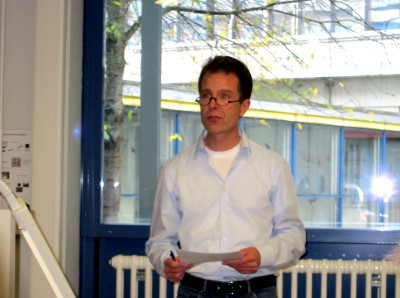 This year's BreMarE Day was convened 26 November 2014 by Bremen Marine Ecology - Center for Research & Education of the University of Bremen.
This year's BreMarE Day was convened 26 November 2014 by Bremen Marine Ecology - Center for Research & Education of the University of Bremen.
Prof. Dr. Wilhelm Hagen, Vice Dean of the Faculty of Biology and Director of BreMarE welcomed participants. The programme comprised four talks spanning the physical and chemical aspects of lowering oxygen levels in different parts of the ocean and what that means for marine life. Prof. Dr. Michael Friedrich as moderator presented the biodata of the speakers.
Setting the environmental scene, Dr. Lothar Stramma of GEOMAR in Kiel summarised recent research into oxygen levels, their regional variation and how the decrease in oxygen affected tropical ocean-roaming species. The oxygen levels are estimated to have fallen overall by 2% in the last 20 years. The reductions are highest in coastal zones affected by agricultural runoff of excess fertiliser and untreated urban waste waters. But oceanographers have also identified oxygen minima further offshore without direct human inputs believed to be a result of ocean circulation when different water masses meet.
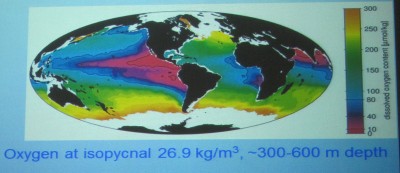 Warmer water can dissolve less oxygen. Low oxygen levels mean that e.g. the powerful big fish once roaming the ocean in abundance, such as blue marlin (Makaira nigricans) and bluefin tuna (Thunnus thynnus), who require well oxygenated water to live, find their habitat is shrinking. In the case of blue marlin, it was estimated that blue marlin had 15% less habitat available in 2010 compared to 1960. This is bad enough, but at the moment, we might add that overfishing poses an even bigger threat.
Warmer water can dissolve less oxygen. Low oxygen levels mean that e.g. the powerful big fish once roaming the ocean in abundance, such as blue marlin (Makaira nigricans) and bluefin tuna (Thunnus thynnus), who require well oxygenated water to live, find their habitat is shrinking. In the case of blue marlin, it was estimated that blue marlin had 15% less habitat available in 2010 compared to 1960. This is bad enough, but at the moment, we might add that overfishing poses an even bigger threat.
In coastal zones, oxygen-free zones can form as is, e.g. observed in the Gulf of Mexico since the beginning of intensive farming in the US since approximately 1860. Oxygen-free water can there trap fish and crabs nearshore. This life-threatening condition is exploited by so-called Jubilee fishing harvesting large quantities of seafood with minimal effort. In Oregon, USA, anoxic events have led to mass mortalities on fish rich reefs down to 50 m depth.
The relative contribution of climate change and more direct human intervention in creating the observed low-oxygen zones varies regionally and is still under investigation. It is estimated that at least 25% of the oxygen decrease in surface waters of the ocean is driven by warming.
Dr. Holger Auel of Bremen Marine Ecology, University of Bremen, presented research by himself and two colleagues, Anna Schukat and Lena Teuber, seeking answers to the question about impacts of oxygen minimum zones (OMZ) in the open sea and hypoxia, excessively low oxygen levels in coastal waters, on plankton communities.
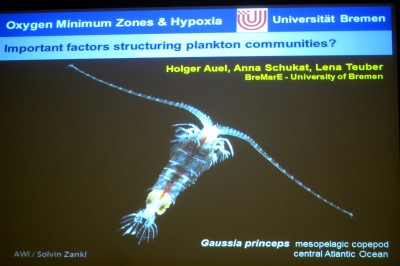 Oxygen minimum zones are considered largely indepent of direct human action. The Pacific and Indian Oceans have more severe OMZs than the Atlantic Ocean (as can be seen from the global distribution map above). In the case of coastal zones suffering from mostly human induced overfertilisation, algal blooms are created in the beginning of excessive supply of nutrients. These tiny plants in the surface waters of the ocean where sunlight reaches, turn part of the energy of sunlight into organic matter. In the process, they produce about half the oxygen in the atmosphere. However, their explosive growth in a so-called “bloom” creates more phytoplankton in a short time than the zooplankton feeding on them can use. The dying and dead phytoplankton cells then sink to the bottom of the sea where they are broken down by bacteria. The bacteria, in turn, need oxygen for the decomposition of the organic matter “raining down” from surface waters. Particularly in warm and shallow parts of the sea, which have little water exchange through currents, this can lead to completely oxygen-free “dead zones”. Only a few sulphor tolerant bacteria and other specialists can survive there, but all other life-forms in a marine ecosystem in oxygen-rich waters are killed or move away.
Oxygen minimum zones are considered largely indepent of direct human action. The Pacific and Indian Oceans have more severe OMZs than the Atlantic Ocean (as can be seen from the global distribution map above). In the case of coastal zones suffering from mostly human induced overfertilisation, algal blooms are created in the beginning of excessive supply of nutrients. These tiny plants in the surface waters of the ocean where sunlight reaches, turn part of the energy of sunlight into organic matter. In the process, they produce about half the oxygen in the atmosphere. However, their explosive growth in a so-called “bloom” creates more phytoplankton in a short time than the zooplankton feeding on them can use. The dying and dead phytoplankton cells then sink to the bottom of the sea where they are broken down by bacteria. The bacteria, in turn, need oxygen for the decomposition of the organic matter “raining down” from surface waters. Particularly in warm and shallow parts of the sea, which have little water exchange through currents, this can lead to completely oxygen-free “dead zones”. Only a few sulphor tolerant bacteria and other specialists can survive there, but all other life-forms in a marine ecosystem in oxygen-rich waters are killed or move away.
Zooplankton species have developed different life-cycles strategies. Some can cope better with low oxygen than others, but the total abundance of zooplankton in low oxygen areas is at least one order of magnitude lower than in well oxygenated water.
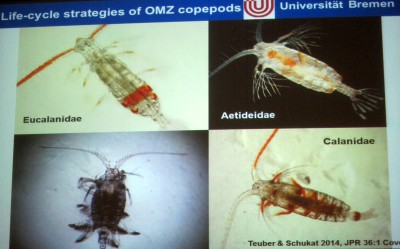 Species of the genus Eucalanus occur in surface waters in normal active mode, but can form a diapause “dormant” state to survive in deeper, low-oxygen waters. Species like Pleuromamma xiphias have developed a survival strategy based on daily vertical migrations. Migrating through the low-oxygen zone during short periods acts as a possible refuge from predation and reduces potential competition. Others drift away or migrate actively to avoid excessive exposure to low oxygen zones. So, while biomass of all organisms is reduced in oxygen deprived waters, at least four types of adaptations have evolved in zooplankton to eke out a living all the same.
Species of the genus Eucalanus occur in surface waters in normal active mode, but can form a diapause “dormant” state to survive in deeper, low-oxygen waters. Species like Pleuromamma xiphias have developed a survival strategy based on daily vertical migrations. Migrating through the low-oxygen zone during short periods acts as a possible refuge from predation and reduces potential competition. Others drift away or migrate actively to avoid excessive exposure to low oxygen zones. So, while biomass of all organisms is reduced in oxygen deprived waters, at least four types of adaptations have evolved in zooplankton to eke out a living all the same.
Dr. Gisela Lannig of the Alfred Wegener Institute Helmholtz Centre for Polar and Marine Research, Bremerhaven, focused her presentation on the physiological coping strategies of ectotherm animals in relation to low levels of oxygen in the environment (hypoxia) and in their blood (hypoxemia). Ectotherms are animals which can not regulate their body temperature in relation to environmental conditions, but to minimal extent in some cases. Fishes, amphibians, reptiles and invertebrates belong to this group.
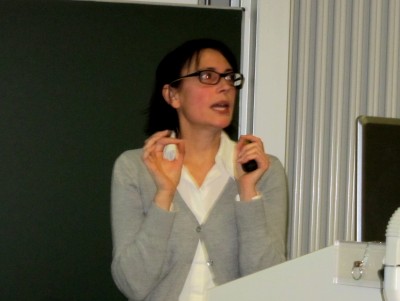 The metabolism of ectotherm animals is strongly affected by temperature, body size and availability of oxygen. Food is a necessary, but insufficient, condition to understand growth, mortality and coping strategies for low oxygen conditions of such animals.
The metabolism of ectotherm animals is strongly affected by temperature, body size and availability of oxygen. Food is a necessary, but insufficient, condition to understand growth, mortality and coping strategies for low oxygen conditions of such animals.
Animals in the intertidal zone are particularly exposed to strong and rapid variations in temperature, oxygen supply and humidity that change with the tide. Burrowing, development of protective shells, air breathing and mobility are among the most common adaptations to this extreme environment.
When oxygen levels fall, animals can switch their metabolism into anoxic mode, which is less energy-efficient but enables survival for limited periods of time. That is e.g. the case of blue mussel (Mytilus). To extend this limited periods of time, intertidal organisms are often capable of metabolic depression. They reduce maintenance costs in a regulated way e.g. by reducing ion channel density, and enter a hypometabolic state. Reducing their metabolism helps to delay cell death and extends survival time (up to days) under energetic stress, e.g. when facing oxygen deficits. To avoid tissue hypoxia/hypoxemia. Mobile animals will move away from the low oxygen zone, if possible. Other animals have evolved physiological adaptations to cope with low environmental oxygen levels and remain aerob. They use e.g improved ventilation and circulation performance or formation of specific respiratory pigments with high affinity to oxygen.
Animals need energy to keep up their body functions. Energy from break-down of carbohydrates (e.g. glucose) or lipids is stored in ATP molecules that transport it throughout the cells. At high oxygen levels the more energy-efficient aerobic metabolism produces 15 to 129 moles ATP/substrate, while at low oxygen levels the metabolism turns anaerobic and produces only 2 to 6 moles ATP/substrate. The cells contract an “energy debt”, that can only last for short periods of time and requires energy pay back for recovery.
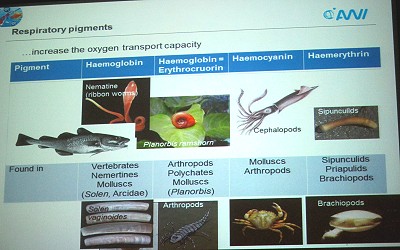 While animals have evolved a number of adaptions to cope with variations in oxygen supply and temperature fluctuations, global warming will put additional strain on their systems. From the research presented mobile generalists are expected to cope better with warming and the other stress factors than cold adapted specialists.
While animals have evolved a number of adaptions to cope with variations in oxygen supply and temperature fluctuations, global warming will put additional strain on their systems. From the research presented mobile generalists are expected to cope better with warming and the other stress factors than cold adapted specialists.
The presentation of the physiological mechanisms also provided insights into the underlying metabolic pathways explaining why gill breathing animals have S-shaped growth curves. In earlier pathbreaking work, Daniel Pauly (1) showed this to be linked at the macro-level to the growth of gas exchange surfaces – gills – to the second power, while body size grows to the third power. Growth stops when the gas exchange through the surface of the gills can not provide enough oxygen for assimilation of food into additional body weight (volume) and evacuate waste products and CO2. Spawning of big females reduces their body weight and allows them another growing season.
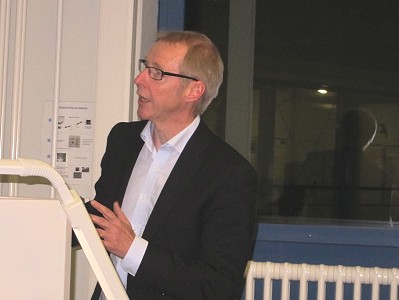 Warming ocean water with less dissolved oxygen will thus reduce growth and distribution range of fish, among others. Further exploring the unifying ecological theory with its physiological underpinning will provide valuable research questions to generations of future scholars in several areas of study.
Warming ocean water with less dissolved oxygen will thus reduce growth and distribution range of fish, among others. Further exploring the unifying ecological theory with its physiological underpinning will provide valuable research questions to generations of future scholars in several areas of study.
Dr Tim Rixen gave a speed talk about findings of research on oxygen minimum zones and upwellings he and colleagues Anita Flor and Celeste Sanchez have conducted at the Leibniz Centre for Tropical Marine Ecology (ZMT) in Bremen.
In most upwelling zones, except in the Benguela system off Namibia and South Africa, CO2 levels are high, suggesting they might be testing grounds for the effects of ocean acidification.
A variety of working hypotheses were tested but rejected on the basis of the empirical evidence. Calcification in skeleton forming organisms is expected to suffer in CO2 rich waters with lowered pH as lower carbonate and aragonate saturation makes life harder for these animals.
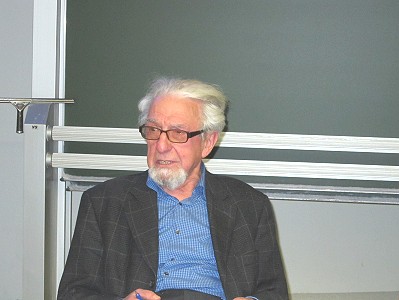 Among the perplexing field observations reported were e.g. corals in Costa Rica which manage to still grow and accrete the top of the reef, but which struggle with carbon dissolution at their base below. The researchers fear that the reefs may experience serious structural damage in the next 20 or so years. They expect fundamental changes in the ecosystem associated with the reef structures as low oxygen leads to demineralisation and species and habitat change.
Among the perplexing field observations reported were e.g. corals in Costa Rica which manage to still grow and accrete the top of the reef, but which struggle with carbon dissolution at their base below. The researchers fear that the reefs may experience serious structural damage in the next 20 or so years. They expect fundamental changes in the ecosystem associated with the reef structures as low oxygen leads to demineralisation and species and habitat change.
One of the concluding slides showed the tentative timeline of reduced growth and decline of different marine organisms with calcareous skeletons if acidification continues unabated. Not a reassuring perspective.
The last 20 minutes were available for a last round of clarifying questions and answers chaired by Prof. Dr. Dr. Gotthilf Hempel, founding director of ZMT.
He concluded the official part with a provocative comment: "It is a fascinating thought that the majority of the students in the room - in fifty years - will witness the outcome of the large man-made experiment called "Global Change". You might then say "Our grandparents have predicted it, but failed to prevent it."
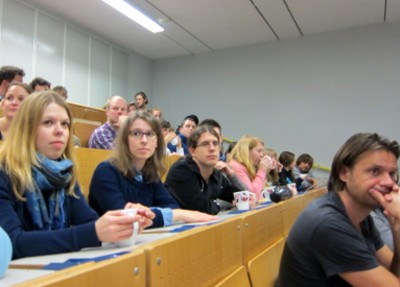 That made the animated conversation continue well into the evening around snacks and drinks.
That made the animated conversation continue well into the evening around snacks and drinks.
At the end, we went home with mixed feelings. Will we fail collectively or can we build conservation values into our "operating system"? Will we pay our debt from ecological overshoot and excessive social inequality? We sensed a certain resolve, but not quite the urgency to act. Yet, we can succeed if we slow down material extractions, transit towards cycle economies and practice more distributional justice. It will make us happier and healthier (2). Science tells us that business as usual will lead us into very dangerous territory nobody can predict. It also provides ample knowledge about our Planet and about what is likely to work. Will we listen to Nature and to one another?
(1) Pauly, D., 2010. Gasping Fish and Panting Squids: Oxygen, Temperature and the Growth of Water-Breathing Animals. Excellence in Ecology Series, Vol. 22, edited by Otto Kinne. Inter-Research, Oldendorf/Luhe, Germany, 216 p.
(2) Wilkinson, R. & K. Pickett, 2010. The Spirit Level. Why Equality is Better for Everyone. London, Penguin, 374 p. (pbk)
For further reading on causes of low oxygen in the Pacific, click here.









